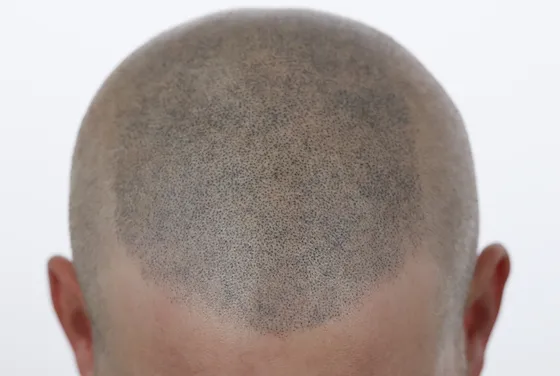Male pattern baldness, also known as androgenetic alopecia, is one of the most common types of hair loss affecting men. It’s estimated that by age 50, about half of men experience some degree of baldness, with the condition often beginning as early as their 20s or 30s. While male pattern baldness is extremely common, its causes are complex, and many men have questions about what triggers this gradual hair loss. In this post, we’ll explore the main causes of male pattern baldness, how it progresses, and some solutions for those looking to regain their confidence.
1. Genetics: The Primary Factor in Male Pattern Baldness
Genetics play a significant role in determining whether or not someone will experience male pattern baldness. If your father, grandfather, or other male relatives experienced hair loss, you are more likely to as well. Male pattern baldness is associated with specific genetic markers on the X chromosome, which is inherited from the mother, although other genes on different chromosomes can also contribute.
The genetic predisposition affects the hair follicles’ sensitivity to certain hormones, leading to a shorter growth cycle and eventually causing follicles to shrink and produce finer, shorter hairs. Over time, some follicles may stop producing new hair altogether.
2. Hormones: The Role of DHT in Hair Loss
Hormones, particularly dihydrotestosterone (DHT), are another major factor in male pattern baldness. DHT is a derivative of testosterone, which binds to androgen receptors in the hair follicles. For men with a genetic predisposition to baldness, DHT affects the hair follicles on the scalp, causing them to shrink progressively. This process, called “miniaturization,” leads to weaker and thinner hair.
As DHT levels increase and interact with sensitive follicles, the growth cycle of the hair becomes shorter, which means that new hairs have less time to grow before they fall out. This cycle continues until the follicles are no longer able to produce visible hair.
3. Age: The Impact of Time on Hair Loss
Age is another factor contributing to male pattern baldness. While some men start experiencing hair loss in their early twenties, most will notice thinning hair as they approach their thirties and forties. Aging changes hormone levels, and hair growth naturally slows as we get older, meaning that hair follicles are less likely to regrow hair after it falls out.
Additionally, the hair that does grow may be weaker and more prone to breakage, adding to the appearance of thinning and bald spots. As the growth phase of hair becomes shorter with age, hair loss becomes more noticeable.
4. Stress and Lifestyle Factors: How Daily Life Affects Hair Health
While male pattern baldness is largely a result of genetics and hormones, stress and lifestyle factors can accelerate the process or worsen its appearance. High levels of stress have been linked to various forms of hair loss, including a condition called telogen effluvium, where hair follicles are pushed into a resting phase and stop growing.
Poor nutrition, insufficient sleep, smoking, and high alcohol consumption can all contribute to weakened hair and make hair loss more pronounced. Maintaining a healthy lifestyle, managing stress, and following a balanced diet can help keep hair and scalp healthier, though they may not fully prevent genetically-driven hair loss.
5. Progression and Patterns of Male Pattern Baldness
Male pattern baldness typically follows a predictable progression, starting with a receding hairline at the temples or thinning at the crown of the head. The most common classification system for hair loss, called the Norwood Scale, outlines various stages of hair loss, from slight recession to more extensive baldness. Recognizing which stage you’re in can help you understand the progression and identify potential solutions sooner.
Solutions for Male Pattern Baldness
While male pattern baldness is largely irreversible, several solutions can help men manage its appearance and restore confidence. Here are some common and effective options:
- Medications:
- Minoxidil: A topical treatment that can slow hair loss and, in some cases, promote new hair growth. However, it requires continuous use to maintain results.
- Finasteride: An oral medication that works by inhibiting the production of DHT, helping to slow or stop hair loss in some men.
- Hair Transplant Surgery:
- Hair transplants involve relocating hair follicles from other parts of the scalp to areas experiencing thinning. While this option can provide natural-looking results, it is typically costly and involves significant recovery time.
- Scalp Micropigmentation (SMP):
- Scalp micropigmentation is a non-surgical solution for men seeking to create the appearance of a fuller head of hair. By applying specialized pigments in the scalp’s upper layer, SMP professionals replicate the look of hair follicles, giving the impression of closely-shaved hair or fuller density in thinning areas. It’s a great option for men looking for a low-maintenance, long-lasting solution without invasive procedures.
- Lifestyle Changes:
- Although lifestyle changes won’t reverse male pattern baldness, maintaining a balanced diet rich in essential nutrients, reducing stress, and avoiding smoking or excessive alcohol can support overall hair health and potentially slow the rate of hair loss.
Conclusion: Understanding Your Options
Male pattern baldness is a common condition with complex causes, from genetics and hormones to lifestyle factors. If you’re noticing early signs of hair loss, exploring these causes can help you make informed decisions about which treatments and solutions might work best for you. For those looking for a non-surgical, confidence-boosting solution, scalp micropigmentation offers a natural-looking option that’s effective for all stages of hair loss.
If you’re interested in exploring SMP as a solution, consider scheduling a consultation to discuss how it can help you achieve a fuller, more defined look that complements your style and preferences. By understanding the causes and solutions available, you’re already on the path toward making a choice that works for you.

